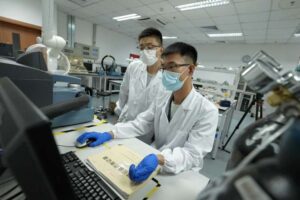
The Union Cabinet’s decision to seed the Research, Development and Innovation Scheme with a ₹1 trillion, a 50-year interest-free loan to the Anusandhan National Research Foundation, is the boldest fiscal wager on science since Independence. By local standards the RDI scheme is a windfall—roughly equal to India’s entire public R&D budget for the last financial year—yet it must be read against Beijing’s numbers. China’s government channels about 730 billion yuan a year into research, or roughly ₹8.5 trillion, while its total national spend tops 3.6 trillion yuan.
India’s marquee fund thus equals barely one-eighth of China’s public commitment and an even smaller slice of its overall spend. Scale, therefore, is necessary but not sufficient; success will hinge on whether New Delhi can translate this money into a disciplined, mission-driven ecosystem that draws in private capital and matches China’s execution.
For a decade, India’s combined public-private R&D spend has hovered below 0.7 per cent of GDP—scarcely a quarter of China’s figure. The new scheme acknowledges that a start-up economy without deep science at its core will soon plateau. Two design features merit applause: the fund-of-funds structure that lets professional managers screen projects, and concessional finance long enough to straddle extended laboratory cycles. Yet key details are still pending. Draft documents suggest the ANRF board will include bureaucrats, scientists and industry leaders, but its final composition will determine whether the corpus crowds in private capital or merely disburses soft loans.
READ I Gig economy risks a social and economic breakdown
China’s playbook: Focus, firepower, feedback loops
Beijing’s ascent from contract manufacturer to technology powerhouse began with the Made in China 2025 programme, which channelled more than $300 billion into 10 strategic industries and was followed by post-pandemic stimulus of around $1.4 trillion. Total R&D outlays reached 2.68 per cent of GDP last year, increasing even as headline growth slowed. Basic research now claims close to seven per cent of total spending, a share that has risen every year since 2015.

Around 40 national laboratories stitch universities, state-owned enterprises and start-ups into what planners call a ‘triple-helix’. The results are visible: BYD has overtaken Tesla in quarterly battery-electric vehicle sales, while Chinese chipmaker Loongson claims its latest server processor matches the performance of Intel’s Ice Lake-generation Xeon parts—an assertion that awaits independent benchmarking but illustrates the country’s confidence.
Three habits underpin this momentum. First, China funds basic science as if it were physical infrastructure. Second, it rewards technology spill-overs through a 200 per cent super-deduction on allowable R&D expenses plus a suite of accelerated depreciation benefits. Third, every ministry publishes scorecards that rank provinces by patents, localisation ratios and technology-readiness levels. Carrots and sticks, not cheques alone, keep projects on schedule.
Fragmented, under-connected schemes
India’s scientific talent is scattered across more than 700 universities and scores of sectoral labs, with frail bridges to industry. The Indian Patent Office granted roughly 100,000 patents in FY 2023-24; resident entities accounted for a little over one-third, leaving the bulk to foreign applicants.
Laboratories frequently stop at Technology-Readiness Level 4, the prototype stage, because incentives to licence out discoveries are weak and private finance rarely bankrolls the expensive climb to Level 9. Customs delays can hold imported equipment at ports for weeks. Money alone cannot dissolve such friction.
Lessons RDI scheme must internalise
Choose battles, not shopping lists: China concentrated capital in electric vehicles, solar, telecoms and quantum computing. India must resist the temptation to sprinkle loans across dozens of “priority” areas. A brutally short list—semiconductors, advanced battery chemistry and critical-materials recycling—would signal seriousness.
Match fiscal ambition with regulatory agility: Patent examination times need to fall below twelve months. Customs clearances for research equipment should be automatic. Faculty promotion metrics must reward industry collaboration.
De-risk private R&D: The 200 per cent weighted tax deduction ended in FY 2016-17 and the 150 per cent version lapsed in FY 2019-20. Restoring a tapered super-deduction tied to localisation thresholds would tilt boardroom maths in favour of research.
Court the diaspora with tenure-track certainty: China’s Thousand Talents Plan lured scholars home with assured grants and lab space. India can top that by offering dual-citizenship paths, portable pensions and fast-track ethics approvals.
Institutionalise metrics and accountability: ANRF should publish quarterly dashboards listing funds disbursed, patents filed, spin-offs incorporated and TRL progression. Transparency will deter the drift that doomed earlier technology funds.
From budget line to national mission
The ₹1 trillion RDI Scheme can become India’s Sputnik moment—provided it imports the managerial virtues, not just the headline numbers, of China’s playbook. Parliament ought to establish an independent Innovation Performance Commission, chaired by the Comptroller and Auditor General, to audit outcomes and penalise slippage.
A sunset clause should compel ANRF to recycle realised returns into a revolving pool, so public money seeds perpetual science. Combine that discipline with a restored tax super-deduction, a diaspora talent visa and a guarantee of single-window logistics for research equipment, and India could plausibly raise its R&D intensity from 0.7 per cent to about 1.2 per cent of GDP within five years—enough to crowd in private capital and trigger a virtuous cycle.
Unless the political class treats research the way it treats highways and high-speed data—projects that alter daily life—the promise of a one-lakh-crore cheque will fade into the long ledger of noble intentions. The Cabinet has opened the purse; it must now guard the purpose.
